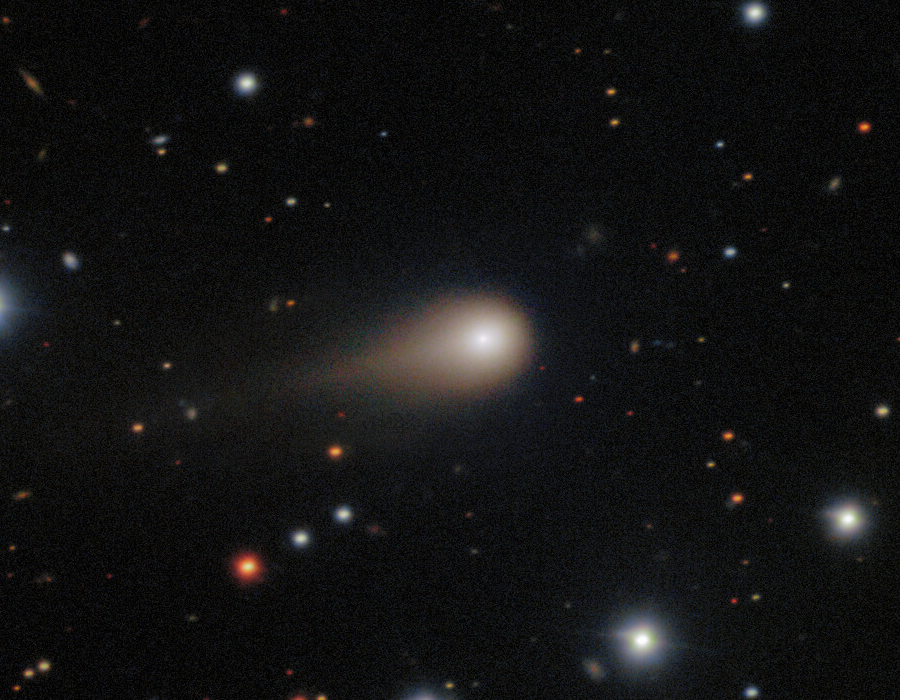
Imagine gazing at the night sky and spotting a visitor from beyond our solar system. That’s exactly what happened this summer. On July 1, 2025, astronomers caught their first glimpse of Comet 3I/ATLAS, an interstellar comet racing through our cosmic neighborhood. This rare guest, the third of its kind, carries whispers from distant stars. As it hurtles toward the Sun, scientists scramble to decode its story. In this article, we explore Comet 3I/ATLAS’s journey, its unique traits, and why it captivates us all. Accordingly, we dive into the excitement surrounding this celestial traveler.
A Serendipitous Discovery Lights Up the Skies
Astronomers first spotted Comet 3I/ATLAS thanks to a vigilant telescope in Chile. The Asteroid Terrestrial-impact Last Alert System, or ATLAS, scans the heavens nightly for potential threats. On that fateful evening, it flagged an odd object. Initially, experts debated its nature. Was it a rocky asteroid or a frosty comet? However, quick follow-ups revealed a faint glow—a coma of gas and dust. This confirmed Comet 3I/ATLAS as a comet, not just any comet, but an interstellar one.
For instance, early images from Chile’s Deep Random Survey showed a subtle tail stretching three arcseconds long. Meanwhile, telescopes in Arizona and Hawaii chimed in with similar findings. By July 2, the verdict was clear. Comet 3I/ATLAS hurtles on a hyperbolic path, unbound by our Sun’s gravity. It will swing by and exit forever. Above all, this discovery thrills because it builds on past interstellar visits. Remember ‘Oumuamua in 2017 and Borisov in 2019? Comet 3I/ATLAS joins them as the third confirmed outsider.
Moreover, the ATLAS team in Río Hurtado played a starring role. Their system, funded by NASA, hunts for near-Earth objects. Yet, it stumbled upon this gem from afar. As a result, global observatories mobilized. From Mauna Kea in Hawaii to the Lowell Discovery Telescope in Arizona, eyes turned skyward. Consequently, data poured in, painting a picture of an ancient wanderer.
Charting the Path: Where Did Comet 3I/ATLAS Come From?
Now, let’s trace its origins. Comet 3I/ATLAS entered our solar system from the direction of Sagittarius, near the Milky Way’s bustling core. This surprised many. Previously, experts expected more visitors from the solar apex—the point where our Sun plows through space. Instead, this comet hails from the southern sky, opposite that direction. For example, its trajectory defies predictions, hinting at hidden dynamics in our galaxy.
Furthermore, backward simulations reveal its age. Estimates suggest Comet 3I/ATLAS could be 3 to 14 billion years old. That’s older than our 4.6-billion-year-old solar system! If true, it formed in the Milky Way’s infancy, perhaps in a distant protoplanetary disk. As it traveled billions of years, gravitational tugs from stars flung it our way. In essence, this comet serves as a time capsule, frozen since the galaxy’s youth.
At the same time, its speed underscores its foreign roots. Moving at over 50 kilometers per second, it outpaces typical solar system comets. Yet, despite this velocity, it poses no danger. The closest it approaches Earth? About 1.8 astronomical units—roughly 170 million miles away. That’s farther than Mars on average. Therefore, stargazers can watch without worry.
Up Close with the Pros: Telescopes Capture Comet 3I/ATLAS in Stunning Detail
Space agencies wasted no time. NASA’s Hubble Space Telescope snapped its first image on July 21, 2025. At 277 million miles distant, the comet appeared as a teardrop-shaped dust cocoon around a solid nucleus. Because Hubble tracked the moving target, background stars streaked like cosmic brushstrokes. This view revealed the comet’s icy heart shedding layers as it warmed.
Later, on August 6, the James Webb Space Telescope joined in. Using its Near-Infrared Spectrograph, JWST detected rich carbon dioxide emissions. This gas, frozen solid in cold space, sublimates near our Sun. Accordingly, the findings suggest Comet 3I/ATLAS formed far from its birth star, in frigid outer regions. For comparison, solar system comets often lack such abundance. Thus, this outsider highlights diverse chemistries across the galaxy.
Ground-based efforts complemented these feats. The Gemini South Observatory in Chile captured vivid photos in July, showing a growing tail. Meanwhile, ESA’s telescopes in Hawaii and Australia tracked its faint coma. As September waned, visibility faded. The comet dipped too close to the Sun for safe viewing. However, it promises a comeback in late November, post-perihelion.
The Fiery Approach: What Happens When Comet 3I/ATLAS Meets the Sun?
Excitement peaks now. On October 30, 2025, Comet 3I/ATLAS reaches perihelion—its solar closest approach. At 1.4 astronomical units, just inside Mars’ orbit, the Sun’s heat intensifies. Ices vaporize, birthing jets of gas and dust. Recent studies liken its water loss to a “fire hose on full blast.” For instance, observations show it shedding water vapor at unprecedented rates, even beyond Jupiter’s orbit.
Why so active? Interstellar comets endure long voyages without disturbance. Thus, their ices remain pristine. When sunlight hits, the outgassing explodes. This formed its coma unusually far out—past Jupiter, at five times Earth’s distance from the Sun. Normally, comets wait until closer in. Consequently, Comet 3I/ATLAS sports a robust tail, visible to amateur scopes through September.
After perihelion, it zips by Venus on November 3, at 0.65 AU. Here, ESA’s Juice spacecraft—bound for Jupiter—may snag bonus views. Juice’s cameras and spectrometers could probe its composition mid-flight. This “once-in-a-lifetime” chance excites teams. Meanwhile, Mars-orbiting probes like ExoMars Trace Gas Orbiter and Mars Express already observed it in early October. Their images show a fuzzy dot—the nucleus haloed by a kilometers-wide coma.
In addition, these encounters reveal dynamics. Gas jets might nudge the nucleus, altering spin or path slightly. Yet, overall, the comet stays stable. No breakup expected, unlike fragile kin. Therefore, it exits our system intact, a fleeting messenger.
Gifts from Afar: What Comet 3I/ATLAS Reveals About Distant Worlds
Beyond spectacle, Comet 3I/ATLAS offers profound insights. First, its chemistry. JWST data flags carbon dioxide dominance, rare in local comets. This implies formation in ultra-cold zones, perhaps around a red dwarf star. Such stars, common in the early galaxy, host diverse disks. As a result, we glimpse exoplanet-building blocks from eons ago.
Moreover, its age challenges models. If billions of years old, it predates our Sun. How did it survive? Gravitational ejections from young clusters, perhaps. Simulations suggest trillions roam interstellar space. Detecting three in a decade hints at abundance. Accordingly, future surveys like Vera Rubin Observatory will hunt more.
On the flip side, debates swirl. Avi Loeb speculated alien tech, but peers dismissed it. Observations confirm natural origins—a coma and tail scream comet. For example, no anomalous acceleration like ‘Oumuamua’s. Instead, focus shifts to science. Carbon monoxide lines, dust grains—each clue maps galactic history.
Furthermore, interstellar objects like Comet 3I/ATLAS bridge solar systems. They carry unaltered materials, unlike our battered locals. By comparing, we probe universal processes. Did similar visitors seed Earth with water? Evidence mounts. Thus, this comet enriches astrobiology too.
Echoes of Controversy: Not All Agree on Its Secrets
Even as unity prevails, sparks fly. Loeb’s paper questioned its trajectory stats, fueling headlines. Critics like Scott Manley called it flawed. After all, data screams natural. Yet, the buzz underscores curiosity. In brief, healthy debate drives progress.
Similarly, origin theories vary. Some tie it to the galactic center’s chaos—black holes, star bursts. Others favor quiet outskirts. New studies hint at early Milky Way frontiers, dense with gas clouds. As research unfolds, clarity emerges.
Peering Ahead: The Legacy of Comet 3I/ATLAS
As Comet 3I/ATLAS fades from view, its impact lingers. Ground telescopes lose it soon after perihelion. Spacecraft glimpses offer last hurrahs. Then, it vanishes into the void, bound for Andromeda perhaps.
Yet, lessons endure. We refined tracking, from precovery hunts in old archives to real-time alerts. ESA’s Planetary Defence Office honed skills, though no threat loomed. In addition, public awe surged. Social media buzzed with photos, inspiring young stargazers.
To illustrate, amateur astronomers worldwide shared tailside views. Schools hosted watch parties. This comet democratized wonder. After that, funding may boost interstellar hunts. Missions like NASA’s Interstellar Probe could chase kin.
In the long run, Comet 3I/ATLAS reminds us: space connects us all. Billions of years, light-years—distances shrink under shared skies. As we decode its frost, we honor the cosmos’s grand tapestry.
In summary, this interstellar comet transforms fleeting flyby into enduring quest. It challenges assumptions, sparks joy, and beckons more discoveries. What secrets will the next visitor whisper? Only time will tell if we made the right choice to listen closely. Ultimately, Comet 3I/ATLAS proves the universe thrives on surprises, urging us onward.

Leave a Reply